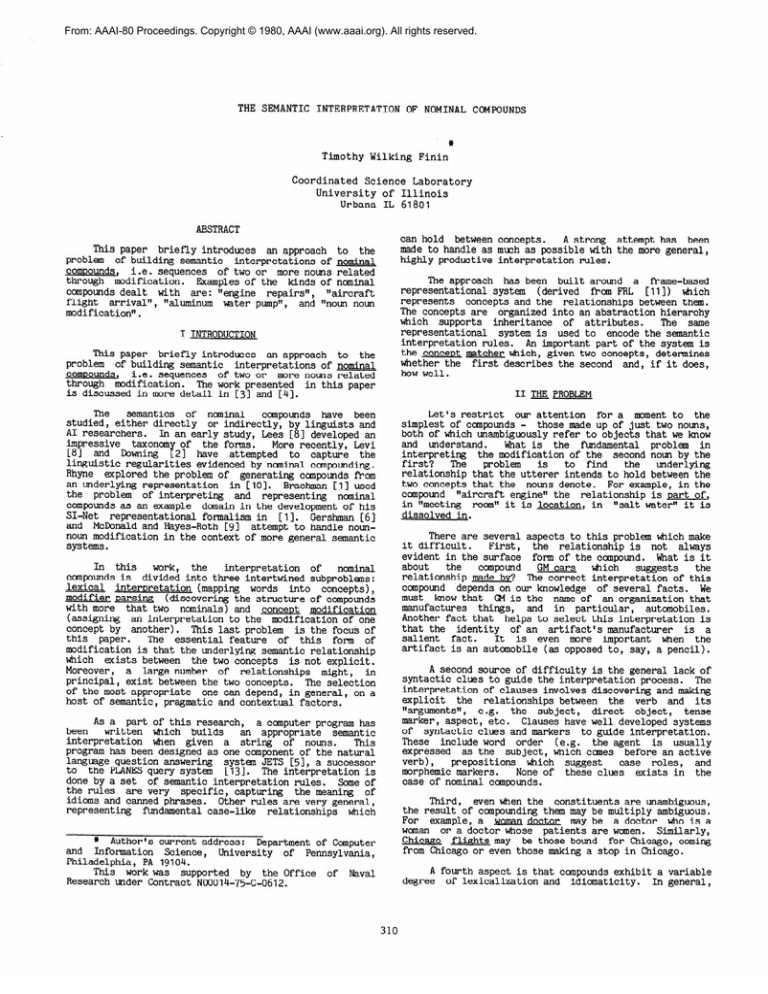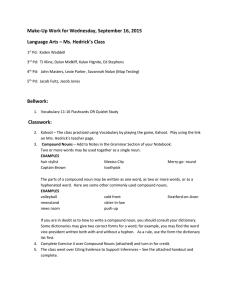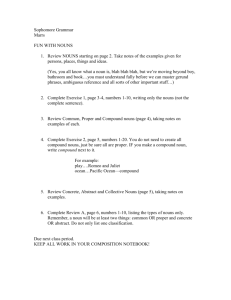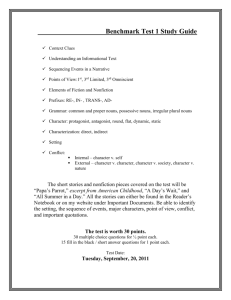
From: AAAI-80 Proceedings. Copyright © 1980, AAAI (www.aaai.org). All rights reserved.
THE SEMANTIC INTERPRETATION OF NOMINAL COMPOUNDS
*
Timothy Wilking Finin
Coordinated Science Laboratory
University of Illinois
Urbana IL 61801
ABSTRACT
This paper brieflyintroduces an approach to the
problem of buildingsemantic interpretations
of nominal
ComDounds, i.e. sequences of two or more nouns related
through modification. Examplesof the kinds of nominal
compoundsdealt with are: "engine repairs", "aircraft
flight arrival",~aluminum water pump", and "noun noun
modification".
I INTRODUCTION
This paper brieflyintroduces an approach to the
problem of buildingsemantic interpretations
of nominal
COmDOundS, i.e. sequences of two or more nouns related
through modification. The work presented in this paper
is discussedin more detail in [3] and [4].
The
semantics of ncminal compounds have been
studied,either directly or indirectly,by linguistsand
AI researchers. In an early study, Lees [8 3 developedan
impressive taxoncm of the forms. More recently,Levi
II81 and Downing f21 have attempted to capture the
linguisticregularitiesevidencedby nominalccmpounding.
Rhyne exploredthe problemof generatingcanpoundsfrom
an underlyingrepresentationin [JO]. Bra&man Cl] used
the problem of interpretingand representing nominal
compoundsas an example domain in the developmentof his
SI-Net representational
formalismin [l]. Gershman[6]
and McDonaldand Hayes-Roth[9] attemptto handle nounnoun modificationin the contextof more generalsemantic
systems.
In this work, the interpretationof nominal
compoundsis dividedinto three intertwinedsubproblems:
lexical internretation
(mapping words into concepts),
modifiernarsina (discovering
the structureof compounds
with more that two nominalsjand concert modification
(assigning an interpretation
to the modificationof one
conceptby another), This last problem is the focus of
this paper. The essentialfeature of this form of
modificationis that the underlyingsemanticrelationship
which existsbetween the two concepts is not explicit.
Moreover, a large number of relationshipsmight, in
principal,exist betweenthe two concepts. The selection
of the most appropriate one can depend,in general,on a
host of semantic,pragmaticand contextualfactors.
As a part of this research, a computerprogramhas
been written which builds an appropriate semantic
interpretationwhen given a string of nouns. This
programhas been designedas one componentof the natural
languagequestionanswering systemJETS 151, a successor
to the PLANESquery system [133. The interpretation
is
done by a set of semanticinterpretation
rules. Some of
the rules are very specific,capturing the meaning of
idiomsand cannedphrases. Other rules are very general,
representing fundamentalcase-like relationshipswhich
* Ailthor's
currentaddress: Departmentof Ccmputer
and Information Science, University of Pennsylvania,
Philadelphia,PA 19104.
This work was supported by the Office of Naval
Researchunder ContractNOOOlll-75-C-0612.
310
can hold betweenconcepts. A strong attempthas been
made to handle as much as possiblewith the more general,
highly productiveinterpretation
rules.
The approach has been built around a frame-based
representational
system (derived from FRL [ill) which
represents conceptsand the relationships
betweenthem.
The conceptsare organizedinto an abstractionhierarchy
which supports inheritance of attributes. The same
representationalsystem is used to encode the semantic
interpretation
rules. An importantpart of the system is
the concertmatcherwhich,given two concepts,determines
whether the first describesthe second and, if it does,
how well.
II THE PROBLEM
Let's restrict our attention for a moment to the
simplestof ccmpounds- those made up of just two nouns,
both of which unambiguously
refer to objectsthat we know
and understand. What is the fundamental problem in
interpreting the modificationof the secondnoun by the
first? The problem is to find the underlying
relationshipthat the utterer intendsto hold betweenthe
two conceptsthat the nouns denote. For example,in the
compound "aircraftengine"the relationshipis part of,
in "meeting room" it is location,in "saltwater" it is
dissolvedin.
There are severalaspectsto this problemwhich make
it difficult. First, the relationshipis not always
evidentin the surface form of the compound. What is it
about the compound GM cars which suggests the
relationshipmade bv? The correctinterpretation
of this
compound dependson our knowledge of severalfacts. We
must know that a is the name of an organizationthat
manufactures things, and in particular, automobiles.
Anotherfact that helps to select this interpretation
is
that the identity of an artifact'smanufacturer is a
salient fact. It is even more important when the
artifactis an automobile(as opposedto, say, a pencil).
A second sourceof difficultyis the general lack of
syntacticclues to guide the interpretation
process. The
interpretation
of clausesinvolvesdiscoveringand making
explicit the relationships
between the verb and its
"arguments", e.g. the subject, direct object, tense
marker,aspect,etc. Clauseshave well developedsystems
of syntacticclues and markers to guide interpretation.
These includeword order (e.g. the agent is usually
expressed as the subject,which canes beforean active
verb), prepositionswhich suggest case roles, and
morphemicmarkers. None of these clues exists in the
case of nominalcompounds.
Third, even when the constituentsare unambiguous,
the result of compoundingthem may be multiplyambiguous.
For example,a woman doctor may be a doctor who is a
woman or a doctorwhose patientsare women. Similarly,
Chicano fliQhtSmay be those bound for Chicago,coming
from Chicagoor even those makinga stop in Chicago.
A fourthaspect is that compoundsexhibita variable
degree of lexicalization
and idiomaticity.In general,
the same compoundform is used for lexicalitems (e.g.
duck soup, hanger queen) and completely productive
expression(e.g.enginemaintenance,facultymeeting).
Finally,I point out that it is possiblefor any two
nouns to be ccmbinedas a compound and be meaningfulin
some context. In fact, there can be arbitrarily many
possible relationships between the two nouns, each
relationship
appropriatefor a particularcontext.
III m
perspective. This class contains the most general
semanticinterpretation
rules - preciselythe ones which
help to achieve a degree of closurewith respect to
semanticcoverage[5]. Similarstructuralrules form the
basis of the approaches of Bra&man Cl] and McDonaldand
Hayes-Roth C91. This section presents some of the
structuralrules I have catalogued. Each rule handlesa
compoundwith two constituents.
INTERPRETATION
RULES
The implemented systemcontains three components,
one for each of the three sub-problems
mentionedin the
introduction.The lexicalinternretermaps the incoming
surfacewords into one or more underlyingconcepts. The
concertmodifier takes a head concept and a potential
modifying concept and produces a
set of possible
interpretations. Each interpretationhas an associated
score which rates its "likelihoodm. Finally, the
modifierparserappliesa parsingstrategywhich compares
and combinesthe local decisionsmade by the other two
componentsto producea stronginterpretationfor the
entire compound,withoutevaluatingall of the possible
structures (the number of which increasesexponentially
with the number of nouns in the ccmpound). The remainder
of this paper discussessome of the interpretation
rules
that have been developedto drive the conceptmodifier.
Three generalclassesof interpretation
rules have
been used for the interpretationof nominalcompounds.
The first class containsidiomaticrules - rules in which
the relationship created is totallydependent on the
identity of the rule's constituents. These rules will
typically match surfacelexical items directly. Often,
the compoundswill have an idiomatic or exocentric(R)
meaning. As an example,considerthe Navy'sterm for a
plane with a very poor maintenancerecord - a "hanger
queentl.The rule to interpretthis phrase has a pattern
which requirean exact match to the words **hanger"
and
l*queenl*.
The second class consists of productive rules
These rules attempt to captureforms of modifian
which are productivein the sense of defininga general
patternwhich can producemany instantiations.They are
characterizedby the semantic relationships
they create
between the modifying and modified concepts. That is,
the nature of the relationshipis a propertyof the rule
and not the constituentconcepts. The nature of the
conceptsonly determines whetheror not the rule applies
and, perhaps,how strong the resultinginterpretation
is.
For example, a rule for dissolvedin could build
interpretations
of such compounds as l*saltwater" and
(tsugar
water" and be triggeredby compoundsmatchingthe
description:
(a NominalCompound
with
Modifiermatching(a ChemicalCompound)
Modifiedmatching(a Liquid)
preferably(a Water))
The third class contains the structural rules.
These rules are characterizedby the structural
relationshipsthey create between the modifying and
modified concepts. The semantic nature of the
relationshipthat a structuralrule createsis a function
of the concepts involvedin the modification.Many of
these rules are particularly useful for analyzing
compoundswhich containncminalizedverbs.
IV STRUCTURALRULES
I have found this last class to be the most
interesting and important, at least from a theoretical
RULE: RoleValue+ Conceot. The first structural
rule that I present is the most common. It interprets
the modifying-concept
as specifyingor fillingone of the
roles of the modified concept. Some examples of
compounds which can be successfully interpretedby this
rule are:
engine repair (a to-repairwith object = (an engine))
Januaryflight (a to-flywith time = (a January))
F4 flight
(a to-flywith vehicle= (an F4))
enginehousing (a housingwith superpart= (an engine))
iron wheel
(a wheel with raw-umterial= (a iron))
Note that when the compoundfits the form **subject+verb"
or "object+verbllthis works very nicely.
The
applicabilityof this rule is not limited to such
compounds,however,as the last two examplesdemonstrate.
To apply this rule we must be able to answer two
questions. First,which of the modifiedconcept'sroles
can the modifier fill? Obviously some roles of the
modified conceptmay be inappropriate. The conceptfor
the to-repair event has many roles, such as an agent
doing the repairing, an object being repaired, an
instrument, a location, a time, etc. The concept
representing an engine is clearly inappropriate
as the
filler for the agent and time roles, probably
inappropriate
as a filler for the locationand instrument
roles,and highly appropriateas the object'sfiller.
Secondly, given that we have found a set of roles
that the modifier may fill, how do we selectthe best
one? Moreover,is there a way to measure how well the
modifierfits a role? Raving such a figure of merit
allows one to rate the overall interpretation. The
process of determiningwhich roles of a conceptanother
may fill and assigningscores to the alternatives is
called role fitting. This processreturnsa list of the
roles that the modifiercan fill and, for each, a measure
of how "good" the fit is. Each possibilityin this list
represents one possibleinterpretation.Not all of the
possibilitiesare worthy of becoming interpretations,
however. A selectionprocessis appliedwhich takes into
accountthe number of possible interpretations,their
absolutescoresand their scoresrelativeto each other.
Making a role fit into an interpretation
involvesmaking
a new instantiationof the modifiedconcept,and filling
the appropriate role with modifier. Details of this
processare presentedin the next section.
RULE: Conceot+ RoleValue. This rule is similarto
the first,except that the concepts changeplaces. In
interpretationsproduced by this rule, the modified
concept is seen as filling a role in the modifier
concept. Note that the object referred to by the
compound is still an instanceof the modifiedconcept.
Some exampleswhere this rule yields the most appropriate
interpretation
are:
drinkingwater
(a water which is
(an object of (a to-drink)))
washingmachine (a machinewhich is
(an instrumentof (a to-wash)))
maintenancecrew (a crew which is
(an agent of (a to-maintain)))
Again, the applicationof this rule is mediatedby the
role fittingprocess.
* An exocentric compound is one in which the
modifierchangesthe basic semanticcategoryof the head
noun, as in hot dog and ladv finger.
311
and inherited roles of the Host concept;[2] Filter out
any inappropriate
ones (e.g. structural ones); 133 For
each remainingrole, computea score for acceptingthe
RoleValue concept; [4] Select the most appropriate
role(s).
RULE'
Concent+ RoleNominal.
This rule is
app1i.G
when the modified conceptis in the class I
call role nominals,nouns that refer to roles of other
underlying concepts. &glish has but one productive
system for naming role ncminals:the agent of an verb can
commonlybe referencedby addingthe -er or -or suffix to
the verb stem. This shouldnot hide the possibilityof
interpreting many concepts as refer@
to a role in
anotherrelatedconcept. Some examplesare: a studentis
the recipient of a teaching,a pipe is the conduitof a
flowing, a pump is the instrument of a pumping,and a
book is the obiectof a reading.
In the third step, the goodness-of-fitscore is
representedby a signed integer. Each role of a concept
is divided into an arbitrarynumber of facets,each one
representing a different aspect of the role. In
computing the goodness of fit measure, each facet
contributesto the overall score via a characteristic
scoringfunction. The facetswhich currentlyparticipate
includethe following:
This rule tries to find an interpretation
in which
the modifieractually modifiesthe underlyingconceptto
which the role nominalrefers. For example,given *IF4
Pilot'*,the rule notes that ~pilotl*
is a role nominal
refering to the agent role of the to-fly event and
attemptsto find an interpretation
in which l*F4"modifies
that to-fly event. The result is somethinglike "an F4
pilot is the agent of a to-fly event in which the vehicle
is an F4". Some other examplesare:
Requirements descriptionscandidatevalue &match.
Preferences descriptionscandidatevalue shouldmatch
DefaultValue a defaultvalue.
TypicalValues
other very ccmmon values for this role.
Modality
one of Optional,Mandatory,Dependentor
Prohibited.
Multiplicity maximumand minimumnumber of values.
Salience
a measureof the role's importancewith
respectto the concept.
cat food (an objectof (a to-eatwith agent = (a cat)))
oil pump (an instrumentof (a to-pumpwith
object = (an oil)))
dog house (a locationof (a to-dwellwith
agent = (a dog)))
For example,the scoringfunction for the reauirements
facet yields a score incrementof +I for each requirement
that the candidate value matchesand a negativeinfinity
for any mismatch. For the preferencesfacet,we get a +4
for each matchingpreference descriptionand a -1 for
each mismatchingdescription. The saliencefacet holds a
value frcm a 5 point scale (i.e. Verylow,Low, Medium,
High, VeryHigh). Its scoringfunction maps these into
the integers-1, 0, 2, 4, 8.
Viewing a concept as a role nominal (e.g. food as the
object of eating) serves to tie the concept to a
characteristic
activityin which it participates. It is
very much like a relative clause except that the
characteristic
or habitual nature of the relationshipis
emphasized.
VI SUMMARY
RULE: RoleNominal+ Concert. This rule is very
similarto the previousone exceot that it anolieswhen
the modifying conceptis a role -nominal. Thgaction is
to attemptan interpretation
in which the modificationis
done, not by the first concept,but by the underlying
concept to which it refers. For example, given the
compound "pilotschool", we can derive the conceptfor
"an organizationthat teachespeopleto fly". This is
done by noting that pilot refers to the agent of a to-fly
event and then tryingto modify "school" by this "tofly".
This, in turn, can be interpreted by the
Conceot+ RoleNominal rule if school is definedas *'an
organization
which is the agent of a to-teach". This
leads to an attempt to interpret to-flymodifying toteach. The RoleValue+ Conceotrule interpretsto-flyas
fillingthe object (or discipline)role of to-teach.
This paper is a brief introductionto an approachto
the task of buildingsemanticinterpretations
of nominal
compounds. A nominalcompound is a sequence of two or
more nouns or nominal adjectives(i.e.non-predicating)
relatedthrough modification. The concepts which the
nouns (and the compound)denoteare expressedin a framebased representationsystem. The knowledgewhich drives
the interpretationcomes from the knowledge of the
concepts themselves and from three classes of
interpretation
rules. Examplesof the most general class
of interpretation
rules have been given.
REFERENCES
L-11
L-21
Some other examplesof ccmpounds that benefitfrom
this interpretation
rule are newspaperglasses (glasses
used to read a newspaper),driver education (teaching
rfTple to drive),food bowl (a bowl used to eat food out
.
Other Structural Rules
Other
structural
interpretationrules that-?-have identified include
SDecific+Generic
which applieswhen the modifier is a
specializationof the modifiedconcept (e.g. F4 planes,
boy child),Generic+SDecific
tiich applies when the the
modifieris a generalizationof the modified concept
(e.g. BuildingNE43, the integer three),Eauivalencein
which the resultingconceptis descendantfrcm both the
modifier and modifiedconcepts(e.g. woman doctor)and
AttributeTransfer in which a salient attributeof the
modifieris transferredto the modified concept (e.g.
iron will, crescentwrench).
[31
141
151
C61
V ROLE FITTING
[71
181
r.91
II101
[ill
with the Evaluationof
[I21 Tennant,H., **i%perience
The process of role fittingis one in which we are
given two concepts,a RoleValue-anda Host, and attempt
to find appropriateroles in the Host conceptin which
the RoleValueconcept can be placed. Briefly,the steps
carried out by the program are: [ll Collectthe local
NaturalLanguageaestion Answerers**,
Proc. IJCAI$Ltpkp
Japan, 1979.
*IAnEnglishlanguageQuestionAnswering
El31
S steh fob a Large RelationalData Base",CACM, vol.
2Y , PP* 526-539, 1978.
312






